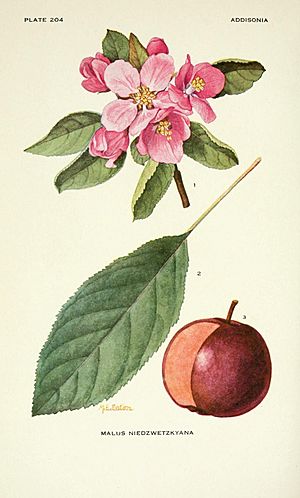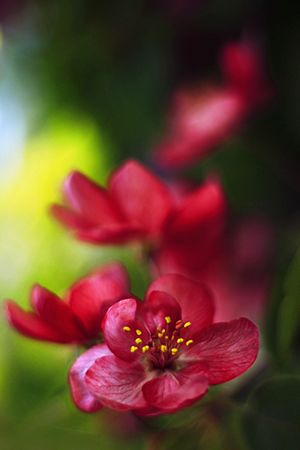Niedzwetzky's apple facts for kids
Quick facts for kids Niedzwetzky's apple |
|
|---|---|
 |
|
| Illustration of Malus niedzwetzkyana from a 1921 botanical compendium | |
| Conservation status | |
| Scientific classification | |
| Genus: |
Malus
|
| Species: |
niedzwetzkyana
|
The Niedzwetzky's apple (scientific name: Malus niedzwetzkyana) is a special type of apple tree. It comes from parts of China, Afghanistan, Kazakhstan, Kyrgyzstan, and Uzbekistan. This apple is famous for its unique red fruit, red skin, and even red flowers!
Some plant experts think it's its own special kind of apple. Others believe it's just a very unusual version of the common apple, Malus pumila.
Niedzwetzky's apple trees are quite rare. They often grow alone, not in big groups. Sadly, they are in danger of disappearing because of farming taking over land and trees being cut down. In Kyrgyzstan, only 111 of these trees are known to still exist.
A group called Fauna & Flora International is working hard to save these trees. They have put the Niedzwetzky's apple on their endangered list. They are also part of a project called the Global Trees Campaign. In 2010 and 2011, they planted over 1000 young trees in forests to help them grow back.
Around 1890, this tree was brought to the Western world. A German plant expert named Georg Dieck grew it from seeds. These seeds were sent by a Russian botanist, Vladislav E. Niedzwiecki, who lived in Turkestan. Later, Dieck shared the trees with a nursery that sent them to the USA around 1896.
Contents
About the Niedzwetzky's Apple Tree
This apple tree can handle cold winters and dry weather. In the wild, it grows about 5 to 8 meters (16 to 26 feet) tall. When grown by people, it stays a bit smaller, under 5 meters (16 feet). It has a round shape and very dark purplish-brown bark.
New branches that grow are dark purple. The leaves start out purplish and turn dark green as they get older. In spring, the tree bursts with bright magenta-rose flowers. These flowers can be as big as 10 centimeters (4 inches) across!
The fruit itself is deep red to purple-red. Sometimes it has a bluish, waxy coating. Inside, the apple flesh can be light to bright red. Even the seeds are dark reddish-brown.
What the Fruit is Like
The Niedzwetzky's apple fruit is safe to eat. It is not very sour. The flesh is a bit dry and chewy. In a part of China called Kashgar, near the borders of Kyrgyzstan and Tajikistan, people call it 'kisil alma'. This means 'red apple'.
Growing and Using This Apple
The Niedzwetzky's apple has been used to create new types of apples and crabapples. These new varieties often have red leaves, red flowers, and red fruit.
It is thought to be the ancestor of an apple called Surprise. This apple has pink flesh and came to the United States around 1840. Later, a plant scientist named Albert Etter used 'Surprise' to create about 30 kinds of pink- and red-fleshed apples. The most famous one is called Pink Pearl.
Another plant expert, Niels Ebbesen Hansen, found the Niedzwetzky's apple in the Ili valley in 1897. He also met Vladislav Niedzwiecki there. Hansen started two projects using this special apple. One was to grow apples that could handle cold weather for cooking and eating. The other was to create pretty crabapple trees for gardens.
His work led to apples like the Almata apple and the Hopa crabapple. Some of these apples, and the Niedzwetzky's apple itself, are now used to make a special pink apple cider.
Special Types of Niedzwetzky's Apple
- 'Red Vein' is one special type of Niedzwetzky's apple.
See also
 In Spanish: Malus niedzwetskyana para niños
In Spanish: Malus niedzwetskyana para niños



